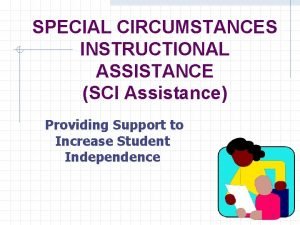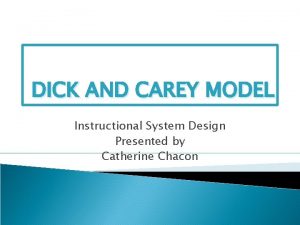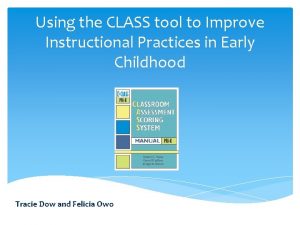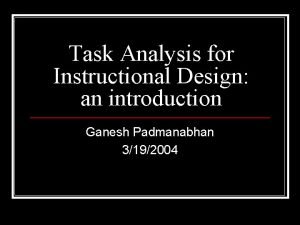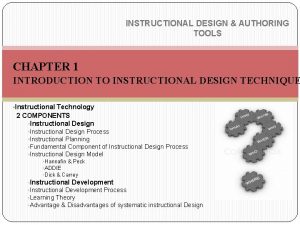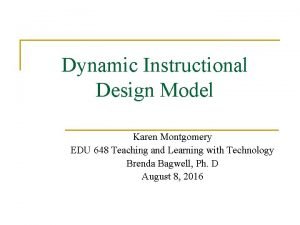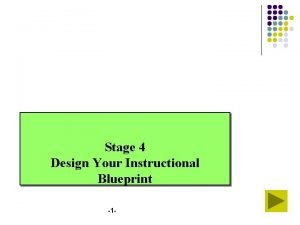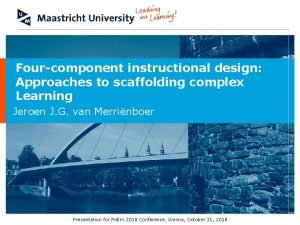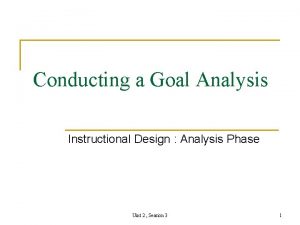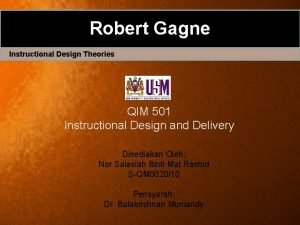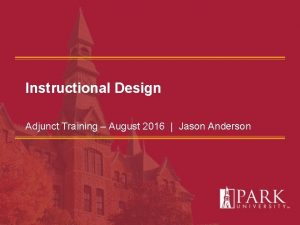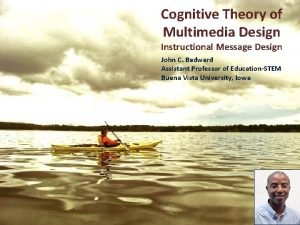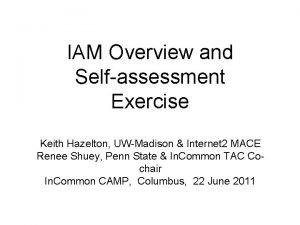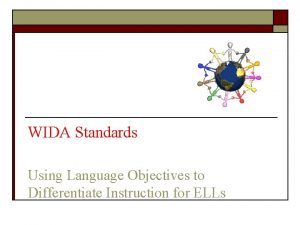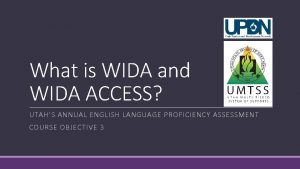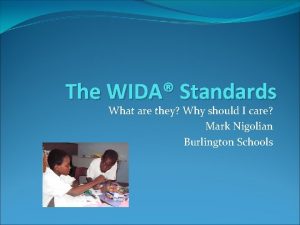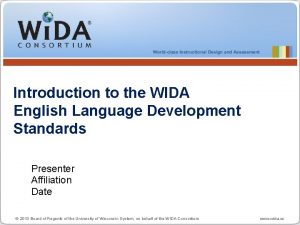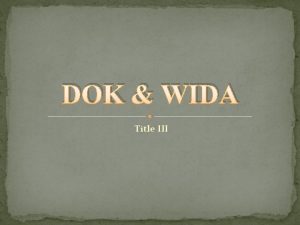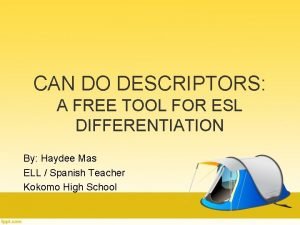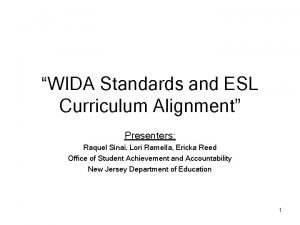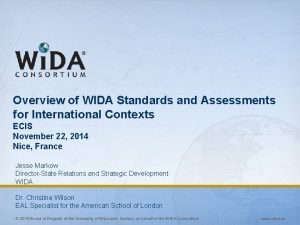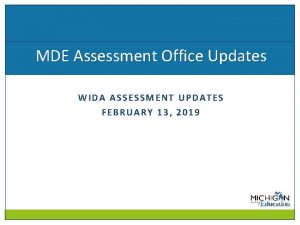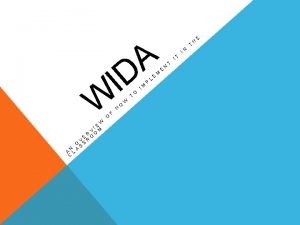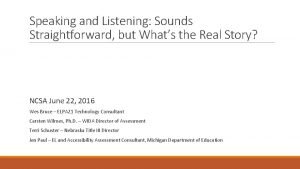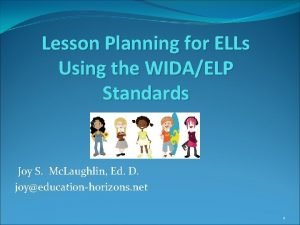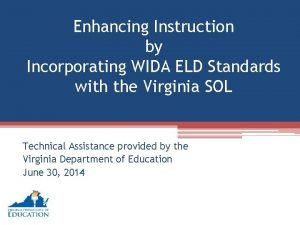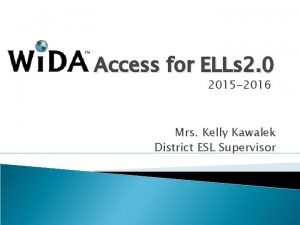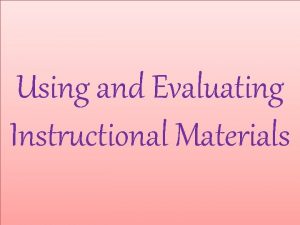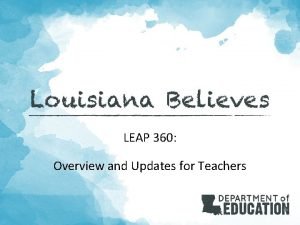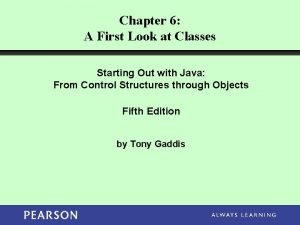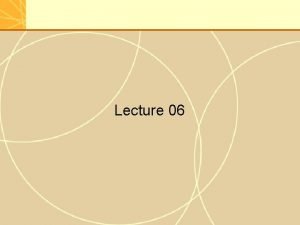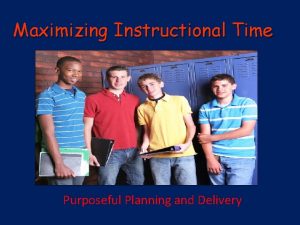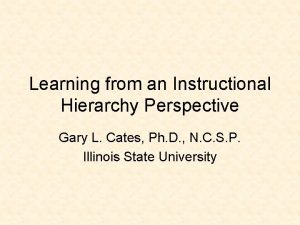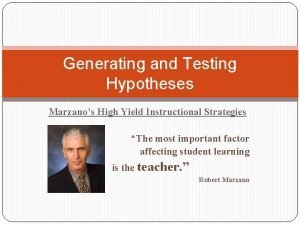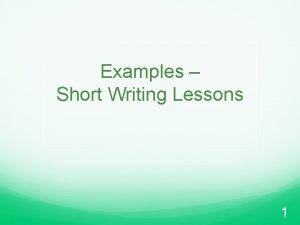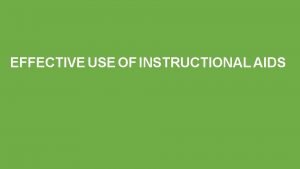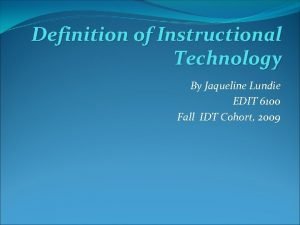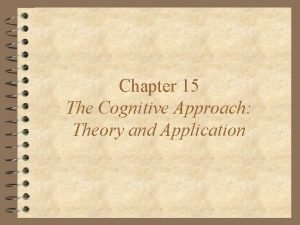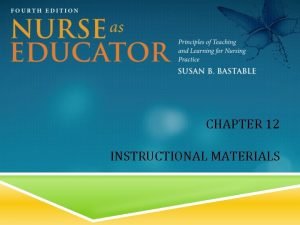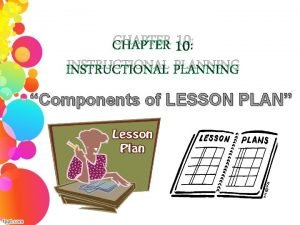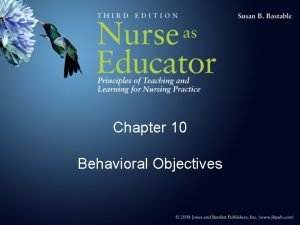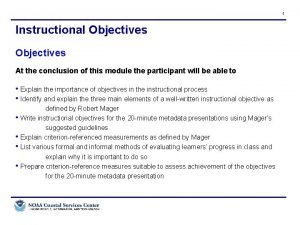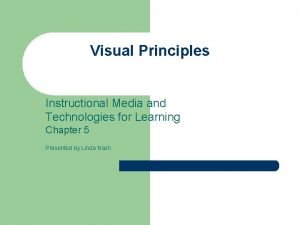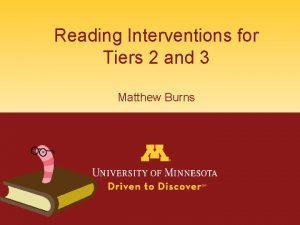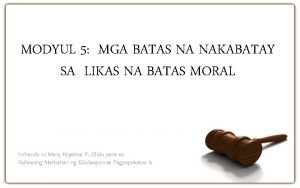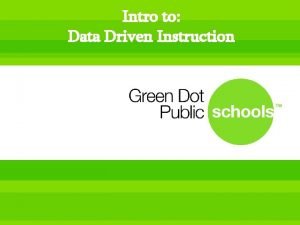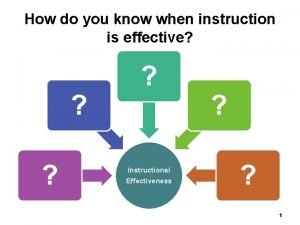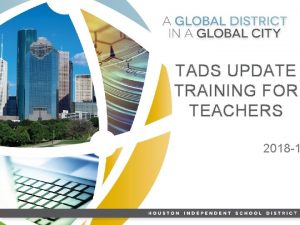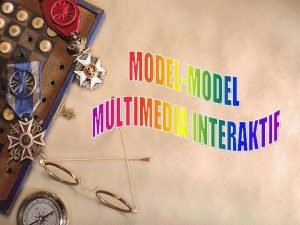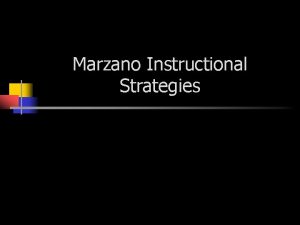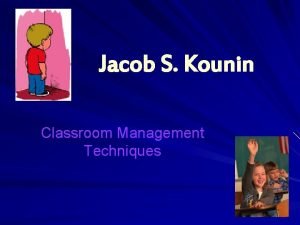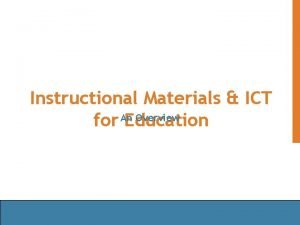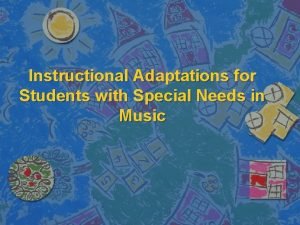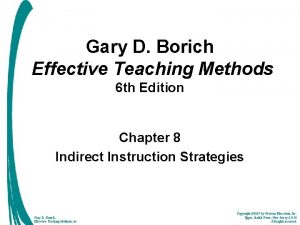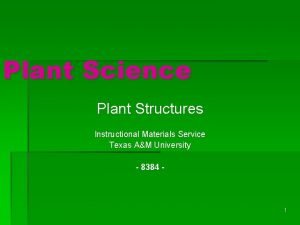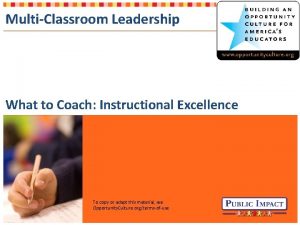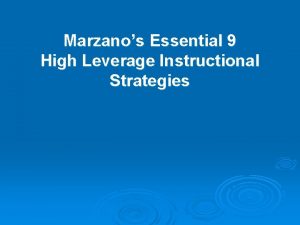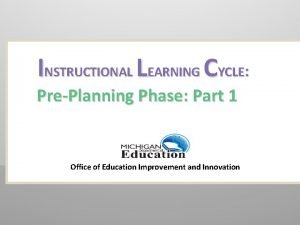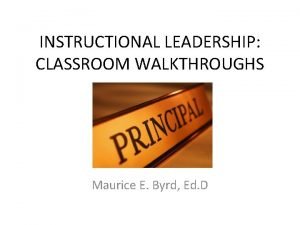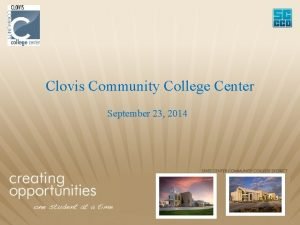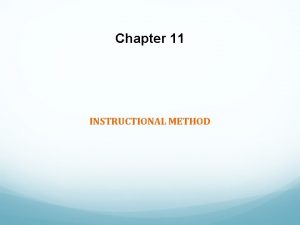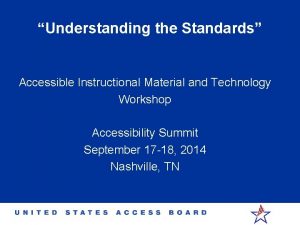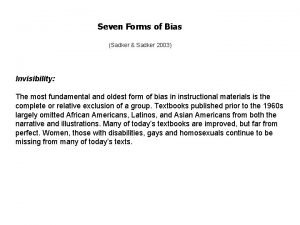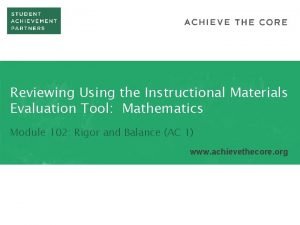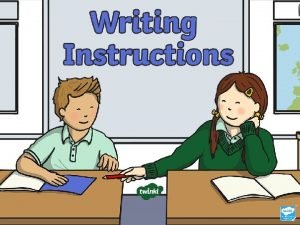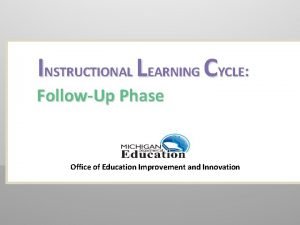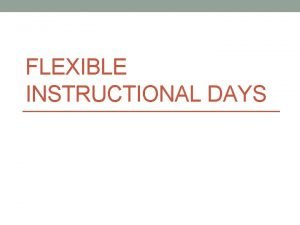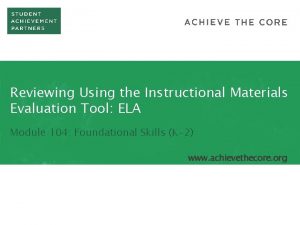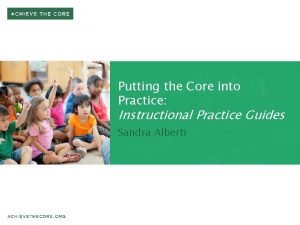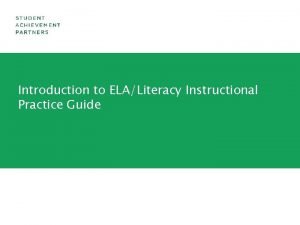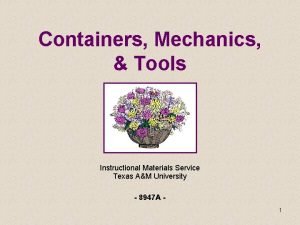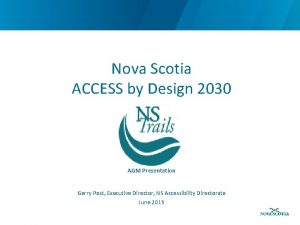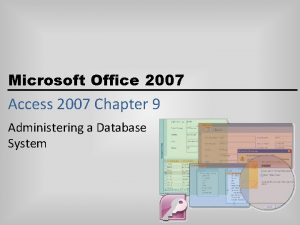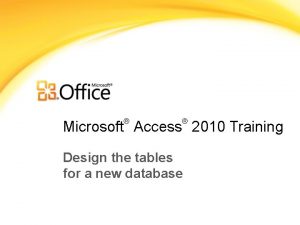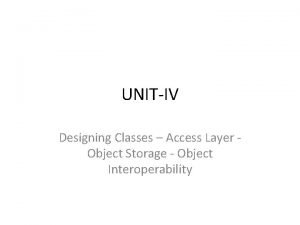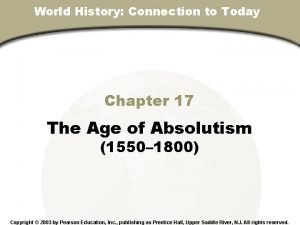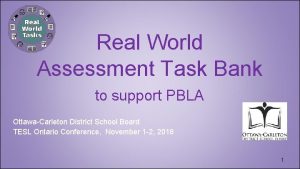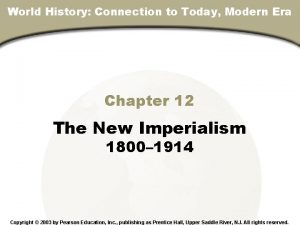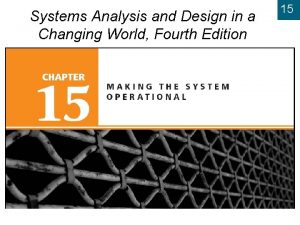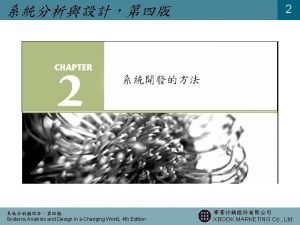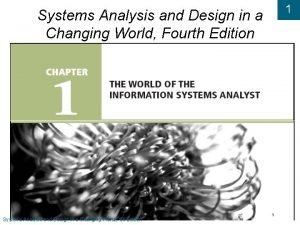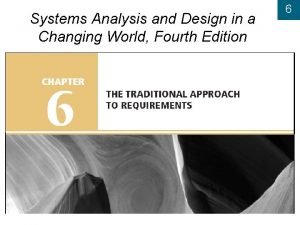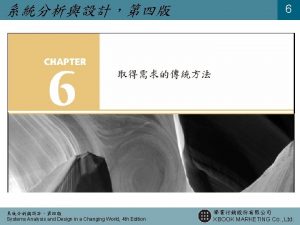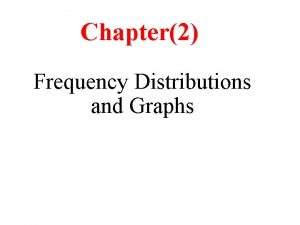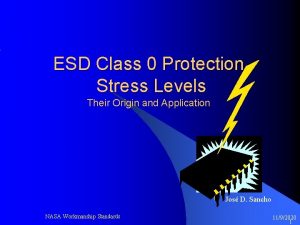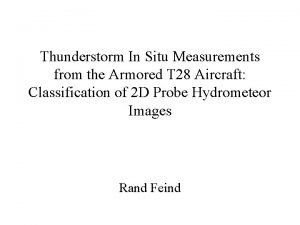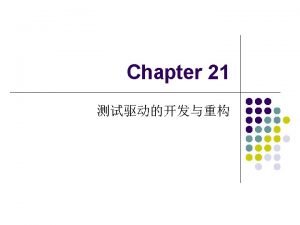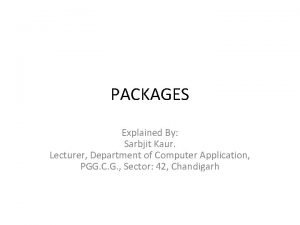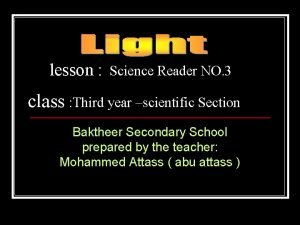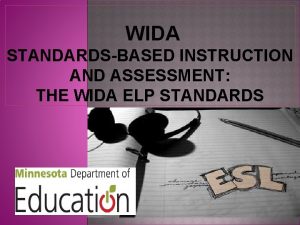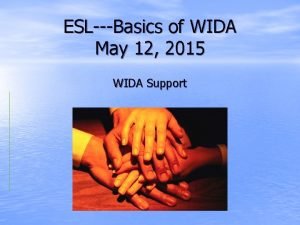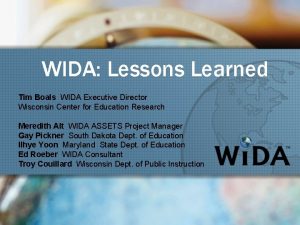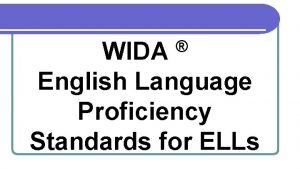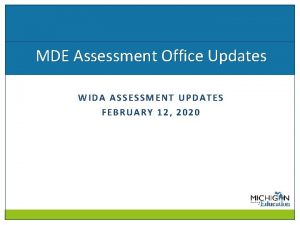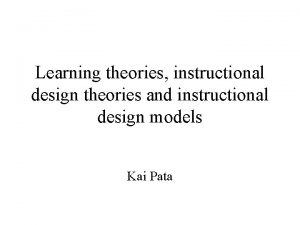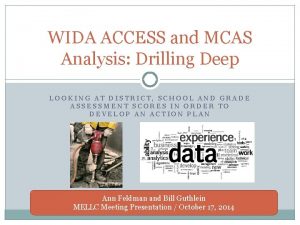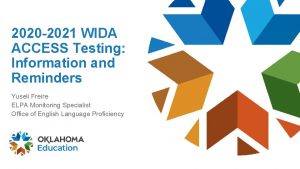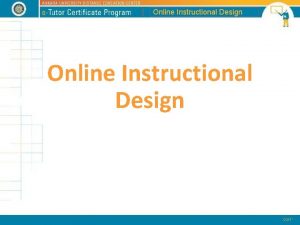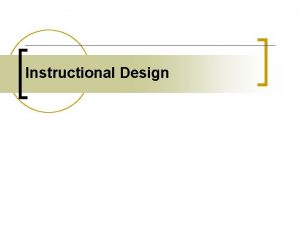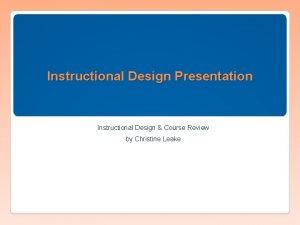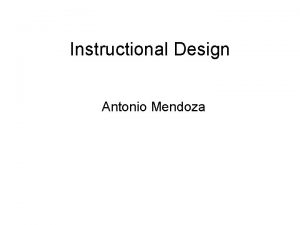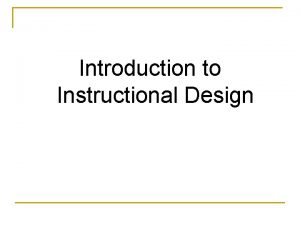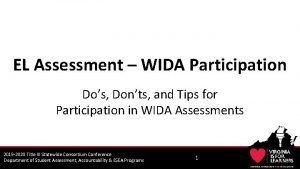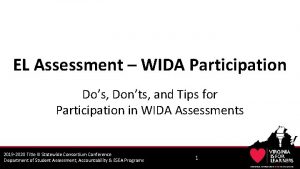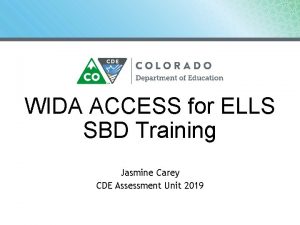World Class Instructional Design and Assessment WIDA ACCESS


































































































































































- Slides: 162

World Class Instructional Design and Assessment (WIDA) ACCESS for ELLs® November 10, 2014 Chris Williams 1 12/13/2021

WIDA ACCESS Placement Test (W-APT™) November 10, 2014 Chris Williams 2 12/13/2021

W-APT™ • Give each new student in your district the home-language survey. • If the answer to any of the 4 required home-language survey questions is any language other than English, then administer the screener, W-APT™. • The W-APT™ is downloadable free to districts from the website: www. wida. us • Contact Chris Williams for a password. • The results of the W-APT™ must be shared with parents within the first 30 days of enrollment or 2 weeks of enrollment during 3 the school year. 12/13/2021

Identified English Learners (EL) Students • • 4 A program services committee will design a Program Services Plan (PSP) for each identified EL student. The teacher will provide services throughout the year with appropriate instructional and assessment accommodations for each individual EL student. All identified EL students are required federally to be assessed annually with an English Language Proficiency test. 12/13/2021

W-APT™ Scores – Grades 1 -12 • For Grades 1 -12, if a student scores an overall composite proficiency level of less than a 5. 0 on the W-APT™ the student is considered an EL and will be placed in an EL program. The student will take ACCESS for ELLs® in January. • For Grades 1 -12, if a student scores an overall composite proficiency of a 5. 0 on the W-APT™ the student is considered Initially Fully English Proficient (IFEP). The student is not an EL and will not take ACCESS for ELLs® in January. 5 12/13/2021

W-APT™ Scores – Kindergarten • Since the K-WAPT™ assesses only listening and speaking and yields only an oral proficiency score (1 -30), all kindergarteners regardless of their K-WAPT™ raw score, must be administered ACCESS the following January in order to assess reading and writing. • Kindergarten students cannot exit an EL program until after taking the first grade ACCESS for ELLs®. • Parents can refuse EL services but the student will still have to take ACCESS for ELLs® in January. 6 12/13/2021

Kindergarten K-WAPT™ Program Options Listening & Speaking Domains Composite Raw Demonstrates Oral Competency Score 29 -30 Exceptional Skill Level • Posted in IC LEP and SEI-Structured English Immersion until 1 st grade ACCESS scores received • PSP designed and implemented for kindergarten school year • ACCESS administered in January Composite Raw Demonstrates Limited Oral Proficiency Score < 29 Low, Mid or High Skill Levels • Posted in IC LEP with appropriate service type • PSP designed and implemented for kindergarten school year 7 • ACCESS administered in January 12/13/2021

Contact Information Chris Williams Office of Assessment and Accountability Division of Support and Research Chris. williams@education. ky. gov (502) 564 -4394 ext. 4750 For more information, please contact WIDA Help Desk: 1 -866 -276 -7735 or help@wida. us 8 12/13/2021

ACCESS for ELLs® November 10, 2014 Chris Williams 9 12/13/2021

ACCESS for ELLs® 2014 -15 - ACCESS Testing Schedule 10 12/13/2021

ACCESS for ELLs® 2014 -15 ACCESS for ELLs®/Alternate ACCESS Testing Schedule® 11 Task Start Date End Date Test Ordering Pre-ID Ordering State Provides Districts Receive Test Materials 10/09/14 11/06/14 Test Window Additional Materials Deadline Districts Pack Completed Material Data Validation Window - If Desired Reports Shipped to Districts Printed Report Correction Window 01/01/15 12/04/14 02/13/15 01/30/15 02/13/15 02/19/15 03/24/15 04/03/15 04/20/15 04/22/15 05/07/15 12/13/2021

ACCESS for ELLs® Exit Criteria Overall Composite of a 5. 0 on a Tier B or C and 4. 0 or higher overall Literacy Composite. 12 12/13/2021

ACCESS for ELLs® ACCESS Ordering 13 12/13/2021

Ordering Materials • Ordering window for ACCESS is October 9 -November 6 • Metri. Tech sent every DAC an e-mail on instructions for ordering their ACCESS materials and passwords • DACs have to go to the Metri. Tech site to order ACCESS materials. Test booklets are ordered from Metri. Tech, Inc. online at www. metritech. com/wida, or by contacting Metri. Tech customer service at (800)747 -4868 14 12/13/2021

Ordering Materials • Districts will receive a 10% overage of ACCESS for ELLs® materials from Metri. Tech • Do not over order; only order what the district needs 15 12/13/2021

• Currently receive literacy instruction only in their native language 16 • ELs who have social language proficiency and some, but not extensive, academic language proficiency in English • Have acquired some literacy in English, though have not yet reached grade level literacy TIER C • ELs who have arrived in the U. S. or entered a school within this academic year without previous instruction in English TIER B TIER A Tier Placement for ACCESS for ELLs® Grades 1 -12 • ELs who are approaching grade level in literacy and academic language proficiency in the core content areas • Will likely meet the state’s exit criteria for support services by the end of the academic year 12/13/2021

Profile 1: Fatima shows language skills typical of a student at level 3, Developing, in most classroom subjects. She is not yet approaching grade-level literacy in the core content areas. Which tier is most appropriate for Fatima? 17 Tier B 12/13/2021

Profile 2: Mohammed is in second grade and in his first year of instruction in English. He is comfortable with basic conversations outside the classroom, but struggles with even low-level reading tasks. Which tier is most appropriate for Mohammed? 18 Tier A 12/13/2021

Profile 3: Esther is approaching grade level literacy in the core academic content areas. Her teacher feels she will likely meet the state’s exit criteria for ELL support services by the end of the academic year. Which tier is most appropriate for Esther? Tier C 19 12/13/2021

Profile 4: Lily shows some emerging proficiency in academic English. She seems comfortable interacting with her fluent English-speaking peers but Lily’s teacher characterizes her as a beginner in reading and writing. Which tier is most appropriate for Lily? A/B line Tier B 20 12/13/2021

Profile 5: Byung’s placement tests reveal level 4. 8 oral proficiency in English, as well as grade-level literacy in his native language. His English reading and writing skills are lower. A portfolio of his work provides evidence that his literacy skills are not yet on grade level. Which tier is most appropriate for Byung? B/C line Tier C 21 12/13/2021

ACCESS for ELLs® Pre-id Labels 22 12/13/2021

Fields in IC for the Pre-id Label • Name (First, Last and Middle Initial) • District Name and Code • School Name and Code • State Student ID (SSID) • District ID (optional)- Do not use SSN #s • Gender • Grade 23 • Date of Birth 12/13/2021

ACCESS for ELLs® Pre-id Label 24 12/13/2021

• Mark if applicable: do not score this section for this student (highlighted in yellow on the test booklet-absent, invalid, declined and special education • Do not apply the label • Bubble in all the information on the test booklet No Label • Apply the pre-id label in the top right hand corner box of the test booklet Incorrect Label Correct Label Pre-id Labels for ACCESS • Bubble all the information on the test booklet 25 12/13/2021

ACCESS for ELLs® Accommodations 26 12/13/2021

ACCESS Accommodations • Only applies to ELs with Disabilities • Must have an Individualized Education Plan (IEP) or 504 Plan • The accommodation must be stated in the IEP or 504 Plan and are marked yes or no and in what domain on the ACCESS roster • Test Booklets are available in large print • No Braille available • Hearing impaired students only take the reading and writing parts of the test • List of appropriate accommodations is located in the ACCESS for ELLs® manual and on the ACCESS online training site 27 12/13/2021

ACCESS for ELLs® Responsibilities and Testing Format 28 12/13/2021

What’s New for ACCESS for ELLs® • New form of ACCESS for ELLs® this year is Form 302. • Listening Test of ACCESS for ELLs®, will be mediabased for all tiers and grades 1 -12. • The Reading Test is designed to take no more than 3545 minutes. IEP or 504 Plan students who require an extended time accommodation will use media-based or script. • There are no changes to the test administration procedures for the Speaking and Writing domains of the assessment. 29 12/13/2021

ACCESS for ELLs® Administration Before districts can administer ACCESS: • Need to give the Administration Code and Inclusion of Special Populations training to their personnel �Each new test administrator on his/her own has to have completed all 3 quizzes of the ACCESS training online with at least 80% accuracy on each quiz before the testing window begins with his/her own unique ACCESS password • Remember to review all the ACCESS online training materials each year 30 12/13/2021

ACCESS for ELLs® Administration �New personnel to your district will need their own ACCESS Training password. Do not share your ACCESS passwords. �Districts will need to contact Chris Williams for ACCESS passwords. �It is a secure test. �Use a # 2 pencil, pens aren’t permitted. �Grade/Tier Header sheets may be duplicated. �Manuals, test materials and other forms can’t be duplicated. �Test booklets may not be distributed to teachers and administrators prior to the testing dates. 31 12/13/2021

DAC or Designee Responsibilities � Order materials from Metri. Tech � Receive and inventory test materials � Document any discrepancies on the Documentation of Materials Not Returned Form � Coordinate the administration and distribution of test materials to schools among your districts � Prepare a list of the following for each school: - Grades to be tested - Amount of testing materials required - Testing schedule � Collect, organize and ship materials to Metri. Tech � Complete rosters in SDRR 32 12/13/2021

BAC Responsibilities � Report any discrepancies with testing materials to the DAC � Inventory all ACCESS for ELLs® materials upon receipt from the DAC � Train personnel with the current Administration Code and Inclusion of Special Populations documents � Deliver and inventory the test materials to each test administrator each day � Disseminate the testing schedules � Verify the EL students who have an IEP or a 504 Plan to be given accommodations � Report issues during testing to the DAC � Add new students or make corrections to EL students in SDRR and IC � Box up all the materials after testing to give to the DAC 33 12/13/2021

Test Administrator Responsibilities • Have had current Administration Code and Inclusion of Special Populations Training • Passed all quizzes on the ACCESS online course with at least 80% accuracy • Read all the manuals • Signed a Nondisclosure agreement • Administered the ACCESS for ELLs® assessment • Returned all testing materials to the BAC each day 34 12/13/2021

ACCESS for ELLs® Administration • Test will be on Form 302 • Listening, Reading and Writing 3 levels of the test: Tiers A, B, and C Speaking has no tiers • Listening, Reading and Writing- 35 Grade level clusters: K, 1 -2, 3 -5, 6 -8, and 9 -12 12/13/2021

The WIDA ELD Standards Standard 1 – Social & Instructional Language (SIL) � English language learners communicate for social and instructional purposes in the school setting. Standard 2 – Language of Language Arts (Lo. LA) � English language learners communicate information, ideas and concepts necessary for academic success in the content area of Language Arts. Standard 3 – Language of Mathematics (Lo. MA) � English language learners communicate information, ideas and concepts necessary for academic success in the content area of Mathematics. Standard 4 – Language of Science (Lo. SC) � English language learners communicate information, ideas and concepts necessary for academic success in the content area of Science. Standard 5 – Language of Social Studies (Lo. SS) 36 � English language learners communicate information, ideas and concepts necessary for academic success in the content area of Social Studies. 12/13/2021

Centrality of the ELD Standards Ongoing Instruction & Assessment W-APT and Summative Formative “Large-scale” ACCESS for “Classroom” ELLs® Assessment Framework English Language Framework Proficiency Standards & Performance Definitions Model Performance Indicators: Formative 37 Model Performance Indicators: Summative 12/13/2021

Overall Organization of Standards Frameworks ELD Standards Grade Level Clusters (5) Language Domain English Language Proficiency Level Model Performance Indicator 38 12/13/2021

Levels of English Language Proficiency EMERGING 39 12/13/2021

Criteria for Performance Definitions EMERGING Linguistic Complexity: Expectations of the quantity and organization of the student’s verbal response Vocabulary Usage: Expectations of the student’s use of appropriate vocabulary for grade level and proficiency level; refers to language quality 40 Language Control: Expectations of the student’s control of English grammar, word choice in context, and the English sound system; refers to language quality 12/13/2021

Elements of Model Performance Indicators The Model Performance Indicators consist of three elements: • The language function describes how students use language - the intent of the communication • The example topic or content stem specifies the context or topic that is addressed - a “curricular kernel” • The type of support generates ideas for approaching instruction and assessment 41 12/13/2021

Organization of MPIs within Standards Level 2 Emerging 42 12/13/2021

MPIs as Basis of Test Items Level 2 Emerging Grades: 6 -8 Level 2: Beginning Standard 1: Social and Instructional Language Match needed resources or supplies with type of activities from pictures and oral statements (e. g. , calculators & mathematic books) Domain: Listening Example topic: Resources & Supplies 43 12/13/2021

Sequence of MPIs within a Theme Folder Tier A Level 2 Emerging MPIs for a Tier A Theme Folder Grades: 6 -8 Standard 1: Social and Instructional Language Domain: Listening 44 Example topic: Resources & Supplies 12/13/2021

Sequence of MPIs within a Theme Folder Tier B Level 2 Emerging Grades: 6 -8 MPIs for a Tier B Theme Folder Standard 1: Social and Instructional Language Domain: Listening Example topic: Resources & Supplies 45 12/13/2021

Sequence of MPIs within a Theme Folder Tier C Level 2 Emerging Grades: 6 -8 Standard 1: Social and Instructional Language MPIs for a Tier C Theme Folder Domain: Listening Example topic: Resources & Supplies 46 12/13/2021

Item Creation Process 47 12/13/2021

Group-Administered Components Listening, Reading and Writing � Administered in groups of up to 22 students � Centrally scored by Metri. Tech not by the Test Administrator � Each grade level cluster and each tier must have separate group sessions � The test administrator scripts arrive with the test booklets and are different for each test form � Scripts are different for each grade level cluster and tier 48 12/13/2021

Test Booklet Organization Test booklet sequence: 1) Listening 2) Reading 3) Writing Each test will begin with practice or sample items Tests are organized by theme folders – A series of questions about one topic with graphic and/or text support Each theme folder for Listening and Reading contains 3 -4 items (test questions) Writing test includes 3 tasks except Grades 1 -2 Tier A has 4 tasks 49 12/13/2021

Test Administration Times • Listening and Reading are administered together in one group session • • Listening Administration: 25 -40 minutes Break in between Listening and Reading sections: 5 minutes Reading Administration: 35 -45 minutes Logistics: 15 minutes (approximately) Writing is administered in a separate group session • Writing Administration: 60 minutes + 5 minutes to finish up (if necessary) • Logistics: 10 -15 minutes (approximately) • 22 students per group session 50 12/13/2021

Scheduling Guidelines- Example 51 12/13/2021

How to Read the Script This page is an excerpt from the beginning of the Test Administrator’s Script that you will receive. 52 12/13/2021

Listening Test Overview The 2013 -2014 Listening Test will be media-delivered (CD or streamed online). Format: Multiple choice, group administered Media: CD or streaming audio from the Internet Time: 25 -40 minutes Scoring: Machine scored (by Metri. Tech, Inc. ) 6 -7 thematic folders: each folder is centered on one standard (Language of: Math, Science, Language Arts, Social Studies, 53 12/13/2021 Social Instructional)

Rationale for Media-Delivered Listening Test Increase standardization of administration Ease the workload of test administrators Test items will be able to reflect more authentic listening scenarios 54 12/13/2021

Listening Test Equipment Needs For the media-delivered format, test administrators need one of the following: CD player Desktop/laptop computer (if playing the CD on the computer or streaming audio from the Internet) Speakers (headphones may not be used to administer the Listening Test) Administration procedures remain the same whether using an audio CD or streaming audio from the internet. 55 12/13/2021

Computer Requirements The table below indicates the necessary minimum computer requirements for streaming the audio. Apple Macintosh Operating System Browser 56 Windows PC Apple i. Pad OS/X 10. 5 or greater Windows XP SP 2 or greater IOS 6. 0 or greater Apple Safari; Mozilla Firefox; Google Chrome Microsoft Internet Explorer 8 or greater; Apple Safari; Mozilla Apple Safari Firefox; Google Chrome Android Tablet Android 4. 0 or greater Android Browser 12/13/2021

Listening Test Guidelines Check CD player or Internet connection strength prior to testing Listen to all tracks. Follow the Test Administration Script exactly. Prior to administering the test, practice administering by listening to the practice items while reading the script. Each track may be played only once. Only under unusual circumstances may tracks be played again. Do not pause between tracks, a 25 second response time already incorporated into the audio. Answer choices may not be read aloud. 57 12/13/2021

Listening Test: Practice Items Two practice items are included to familiarize students with the structure of the test. Practice items will require the test administrator to pause and play the audio files during the track. Follow the instructions in the Test Administrator’s Script exactly. Pausing and playing between tracks are only done during practice items. 58 Practice items are not scored. 12/13/2021

Listening Test Administration Once the Listening test has begun, do not stop or pause the audio. Let the tracks play through to the end. Track 13 contains a 45 -second Check-in. Use this time to circulate the room and make sure that each student has followed the recording to this point, as indicated in the Test Administrator’s Script. Do not press Play or Pause during the Check-in; the track already incorporates 45 seconds of silence in the audio and will automatically advance to continue the test. Prior to the beginning of the next test item, the narrator in the recording will indicate that the test will resume soon. 59 12/13/2021

What to Do in Unusual Circumstances In an emergency event or other unusually disruptive situations such as, 1) a student illness during the test administration, 2) an announcement over the loudspeaker, 3) a fire drill, or 4) a loud noise outside, it is acceptable to stop or pause the audio and attend to the situation. After the situation has been resolved, resume the Listening Test from the beginning of the last test item that was being administered. In the event that you experience technical difficulties (e. g. , the CD player stops working, the CD begins to skip, the Internet connection is interrupted, etc. ), where a considerable amount of time has passed (15 minutes or more), begin the test from the beginning of the Part that was being administered when the interruption occurred. 60 Length of Interruption Less than 15 minutes or more Where to Resume Test Replay current item Replay current Part 12/13/2021

Reading Test Overview � Format: Multiple choice, group administered � Time: 35 -45 minutes � Scoring: Machine scored (by Metri. Tech, Inc. ) � 6 -7 thematic folders: each folder is centered on one standard (Lo. MA, Lo. SC, Lo. LA, Lo. SS, SIL) 61 12/13/2021

Reading Test Guidelines Follow the Test Administration Script exactly Item prompts and answer choices may NOT be read aloud Keep the test going at a steady pace Circulate through the testing room and monitor student work 62 12/13/2021

Individual & Group Check-ins Intended to help guide students through parts of the test Indicated with a stop sign Whole-group check-ins Check in with all of the students at the same time and explain the next part of the test. Occurs after every section in the 1 -2 A Reading Test. Individual check-ins Students raise their hand when they arrive at a stop sign and you check to see if students have completed the section. 63 Occurs halfway through 1 -2 B, 1 -2 C, 3 -5 A, 3 -5 B, 6 -8 A, 9 -12 A and at the end of every reading test 12/13/2021

Writing Test Overview � Format: Student constructed responses, group administered � Time: Up to 60 -65 � Scoring: Rater scored (by Metri. Tech) � 3 Parts: (except Grades 1 -2 Tier A has 4 Parts) � The following standards are covered: � Grades 1 -2 Tier A: SIL � Grades 3 -12 Tier A: SIL, Lo. LA, Lo. MA/Lo. SC � Grades 1 -12 Tiers B & C: SIL, Lo. MA/Lo. SC, IT (Lo. LA/Lo. SS/SIL) 64 12/13/2021

Writing Test Guidelines Keep the test going at a steady pace Circulate through the testing room and monitor student work to keep pace Follow the Test Administration Script exactly Task items (unless scripted) may NOT be read aloud 65 12/13/2021

Individual and Group Check-ins The Writing Test also includes individual and whole-group check-ins After 10 minutes, 20 minutes, and 30 minutes, circulate in the room to monitor students’ progress. Students should be encouraged to keep pace so they can do their best on the longest task at the end. If necessary, you can prompt students who are lagging behind by saying, “Make sure you save enough time for the other parts. ” 66 12/13/2021

Writing Rubric 2 Emerging 67 12/13/2021

Scoring of the Writing Test Rater scored by Metri. Tech using the WIDA Writing Rubric. Student responses are considered first drafts produced under standard testing conditions. Students are not expected to replicate all stages of the writing process they may complete in the classroom. Students should address each task completely; however, the exact quantity of sentences written 68 is not a scoring criterion. 12/13/2021

When Test Administration is Complete Collect test materials after the Listening/ Reading sessions AND the Writing sessions ALWAYS follow test security policies 69 12/13/2021

Speaking Test Overview Format: Student constructed response, no tiers – adaptive format, individually administered Time: Up to 15 minutes per student Scoring: Rated by Test Administrator, scale & proficiency level scores calculated by Metri. Tech Ratings (exceeds/meets/approaches expectations) assigned using Speaking Rubric Each form contains three parts (A, B and C) Part A: tasks 1 -3 cover SIL at proficiency levels 1 -3 Part B: tasks 1 -5 cover Lo. LA and Lo. SS at proficiency levels 1 -5 Part C: tasks 1 -5 cover Lo. MA and Lo. SC at proficiency levels 1 -5 70 12/13/2021

Speaking Test Guidelines Conducted in a one-on-one, question-answer format All questions are standardized and read from a script Student responses to questions are assessed for proficiency using the WIDA Speaking Rubric For extra assistance, a short description of the language you should expect from the student is included in the script Student responses are NOT assessed for accurate content 71 12/13/2021

Format of the Speaking Test � Speaking test contains � A warm-up in which the test administrator puts the student at ease � The test questions � A wind-down in which the test administrator leaves the student with a positive impression of his or her performance on the test. � Test questions are grouped into thematic folders (identified as “parts” within the test) � The targeted proficiency level of each task increases throughout each part � Test is “adaptive, ” that is, questions are presented until the student reaches his or her performance ceiling 72 12/13/2021

Format of a Thematic Folder � Each thematic folder includes a set of tasks and each task includes a set of questions � The speaking test includes three thematic folders, identified as “parts” within the test � Part A: tasks 1 -3 cover SIL at proficiency levels 1 -3 � Part B: tasks 1 -5 cover Lo. LA and Lo. SS at proficiency levels 1 -5 � Part C: tasks 1 -5 cover Lo. MA and Lo. SC at proficiency levels 1 -5 � Each task is aimed at eliciting speech at one particular English Language Proficiency (ELP) level within the WIDA Speaking Rubric � Task 1 aims for speech at ELP level 1 � Task 2 aims for speech at ELP level 2 and so on for further tasks 73 12/13/2021

Task Level Expectations � Every task and question is based on a set of expectations for what the response will look like � Areas of speech around which scoring expectations are based: � Linguistic Complexity: Expectations of the quantity and organization of the student’s verbal response � Vocabulary Usage: Expectations of the student’s use of appropriate vocabulary for grade level and proficiency level; refers to language quality � Language Control: Expectations of the student’s control of English grammar, word choice in context, and the English sound system; refers to language quality � A short description of the language you should expect from the student is included in the script under the Expect box 74 12/13/2021

Speaking Rubric 2 Emerging 75 Speaking Rubric 12/13/2021

The Scoring Scale 76 12/13/2021

Response Marks Exceeds is used when a response scores beyond the expectations of the task Meets is always the intended target for a speaking task Approaches is used when the response does not meet one or more expectations of the task 77 Exceeds Meets Approaches No Response 12/13/2021

Scoring Rules � A rating of Meets or Exceeds each receives a point value of 1 � There are no extra points awarded a score of Exceeds � The Exceeds rating indicates a strong expectation that the student will be able to respond with at least a Meets rating to the following task in the test � A rating of Approaches or No Response each receives a point value of 0 � The zero point value reflects the fact that the student could not meet one or more of the requirements of the scoring rubric 78 12/13/2021

Scoring Rules: Using “? ” � If in doubt between scoring Meets or Approaches on a task, you check the question mark “? ” column on the score sheet and administer the next task � If the student Meets the next task level expectation, assign that task a score of Meets, and go back and assign the previous task in question a score of Meets � If the student fails to meet the task level expectations on the next task, it is most likely that the performance was also deficient on the previous task. Assign the current task a score of Approaches or No Response as appropriate, and go back and assign the previous task in question a score of Approaches � The question mark CANNOT be used on the last task (T 3 in Part A or T 5 in Parts B and C) 79 12/13/2021

Scoring Guidelines � The Speaking Test Scoring Sheet is the last page of the student test booklet � Test administrators must make a mark on the scoring sheet immediately after the student responds to the last question in a task � The answers to all questions in a task are evaluated holistically when making a judgment about the student’s performance on a given task. If the task has several main questions, only one needs to be answered appropriately to meet expectations, provided that one answer demonstrates the expected quality and quantity of language � Students are assessed on what speech they produce, not whether they correctly answer the question you are posing 80 12/13/2021

Navigating the Speaking Test (Grades 1 -12) 81 12/13/2021

Pathway Through the Speaking Test 82 12/13/2021

T 2 Start procedure! The T 2 Start procedure is being introduced in the Speaking test for students taking Tiers B or C of the Listening, Reading and Writing tests This procedure is intended to eliminate the T 1 question(s) that may be too easy for students of higher proficiency Students taking Tiers B or C will begin the Speaking Test from Task 2 (T 2) in Part A Whether or not the student will start on T 2 of Part B and C will depend on his/her performance on the previous T 2 Task Rating and scoring guidelines for each task and discontinuing procedures remain the same during the T 2 Start procedure 83 12/13/2021

Additional Resources on the T 2 Start Procedure Resources providing detailed administration guidelines and information: � Online ACCESS for ELLs® Test Administrator Training Course- Speaking Module (from the WIDA website) � View the T 2 Start procedure Tutorial � District and School Test Administration Manual (downloadable from the WIDA website) � Presentation Administering the Speaking Test T-2 Start Procedure on this Tool Kit � Supporting files in the Speaking Test Administration folder in this Tool Kit 84 12/13/2021

Speaking Test Scoring Sheet for Tier A The scoring sheet should be filled out completely; a score for every task must be marked Any task not administered because the student has reached a ceiling level within a part should be marked as Not Administered If a “? ” is marked for a task and resolved with a Meets or Approaches by administering the following task, it is not necessary to erase the mark 85 12/13/2021

Speaking Test Scoring Sheet for Tiers B and C Updated score sheet reflecting the T 2 Start procedure The scoring sheet should be filled out completely; a score for every task must be marked ACCESS for ELLs® Any task not administered should be marked as Not Administered If a “? ” is marked for a task and resolved with a Meets or Approaches by administering the following task, it is not necessary to erase the mark 86 12/13/2021

Contact Information Chris Williams Office of Assessment and Accountability Division of Support and Research Chris. williams@education. ky. gov (502) 564 -4394 ext. 4750 For more information, please contact WIDA Help Desk: 1 -866 -276 -7735 or help@wida. us 87 12/13/2021

Kindergarten ACCESS for ELLs® Chris Williams November 10, 2014 88 12/13/2021

Training Objectives � To train Test Administrators to administer the Kindergarten ACCESS for ELLs® � To understand the organization, layout and scripting of the tests � To learn the procedures for administering and reliably scoring the tests 89 12/13/2021

Purpose of the Kindergarten Tests Assesses students’ academic English language proficiency Academic language is the vocabulary, grammatical structures and discourse required in learning the academic content of school subject aspects of language strongly associated with literacy development and achievement 90 12/13/2021

The WIDA ELD Standards Standard 1 – Social & Instructional Language (SIL) � English language learners communicate for social and instructional purposes in the school setting. Standard 2 – Language of Language Arts (Lo. LA) � English language learners communicate information, ideas and concepts necessary for academic success in the content area of Language Arts. Standard 3 – Language of Mathematics (Lo. MA) � English language learners communicate information, ideas and concepts necessary for academic success in the content area of Math. Standard 4 – Language of Science (Lo. SC) � English language learners communicate information, ideas and concepts necessary for academic success in the content area of Science. Standard 5 – Language of Social Studies (Lo. SS) 91 � English language learners communicate information, ideas and concepts necessary for academic success in the content area of Social Studies. 12/13/2021

Centrality of the ELD Standards Ongoing Instruction & Assessment Formative “Classroom” Assessment Framework English Language Proficiency Standards & Performance Definitions Model Performance Indicators: Formative 92 Summative “Large-scale” Assessment Framework W-APT and ACCESS for ELLs® Model Performance Indicators: Summative 12/13/2021

Overall Organization of Standards Frameworks ELD Standards Grade Level Clusters (5) Language Domain English Language Proficiency Level Model Performance Indicator 93 12/13/2021

Levels of English Language Proficiency EMERGING 94 12/13/2021

Criteria for Performance Definitions EMERGING Linguistic Complexity: Expectations of the quantity and organization of the student’s verbal response Vocabulary Usage: Expectations of the student’s use of appropriate vocabulary for grade level and proficiency level; refers to language quality 95 Language Control: Expectations of the student’s control of English grammar, word choice in context, and the English sound system; refers to language quality 12/13/2021

Elements of MPIs The MPIs consist of three elements: The language function describes how students use language to demonstrate their proficiency The example topic specifies the context for language instruction, derived from state content standards The support includes instructional strategies or tools used to assist students in accessing content necessary for communication; can be sensory, graphic, or 96 interactive 12/13/2021

Kindergarten Test Design Aligned to Pre. K-K Standards The test is thematically integrated within two stories: A narrative story An expository story All domains (listening, speaking, reading, writing) are tested within each story. All domains are individually administered and adaptive so the student will start sections at appropriate levels and stop at his or her “ceiling. ” All components are scored by the Test Administrator (TA) during test administration In its entirety, the test takes an average of 45 minutes. 97 12/13/2021

Unique Features of the Tests Manipulatives Cards Student Activity Board Thematic Test questions center around two themes All four domains are tested in each theme Interactive Writing Experience The student has an opportunity to produce whatever he/she is able 98 12/13/2021

Narrative vs. Expository Narrative: Appropriate graphics Main characters are animals Description Rhyme, Rhythm Reminiscent of quality children’s literature 3 rd person Fictional 99 Expository: Time sequence Non-fiction Involves “doing” or “how to” Realistic or believable actions with people as main characters Story sequence between steps, logical organization Relate to events in student’s life 12/13/2021

Test Structure The Test Administrator (TA) reads the Narrative storybook, then administers: A. Listening & Speaking Tests (together) B. Writing Experience C. Reading Test The TA will then administer the following sections using the Expository activity board and cards: D. Listening & Speaking Tests (together) E. Writing Experience (starting point is based on Writing Experience score from Part B) 100 F. Reading Test (starting point based on Reading score from Part C) 12/13/2021

Kindergarten Test: Structure Listening and Speaking Writing Reading 101 Move through the Levels of each part until student reaches his/her ceiling Part E (Writing) and Part F (Reading) Starting points are determined by performance on prior Writing and Reading tasks 12/13/2021

Testing Materials (1 of 2) The Kindergarten Student Story Booklet contains: Pictures and story for the Narrative section of the test (resembling authentic children’s literature) Graphic organizers related to designated sections of the test Student Story Booklet Kindergarten Student Response Booklet contains: Answer key for Listening & Reading items Space to record and tally student responses Criteria for moving on/winding down 102 Student writing and teacher transcription of Student Response Booklet 12/13/2021

Testing Materials (2 of 2) Kindergarten Test Administrator Script contains: Moving on/winding down script Expect boxes to assist with scoring students’ speaking responses Kindergarten Student Activity Board Test Administrator Script Kindergarten Cards & Card Pouch Booklet Student Activity Board Cards and Card Pouch Booklet 103 12/13/2021

General Test Administration Procedures Follow the script EXACTLY. Read aloud everything in black bold and blue bold print Student responses must be recorded and scored IMMEDIATELY after each level is complete (e. g. after A 3) You must administer and score all items in any one level of a Part before making a determination about whether to continue to the next level or to stop that Part Kindergarteners may need breaks during the test administration Stretch breaks may be taken between each section of the test (e. g. after Listening/Speaking, before Writing) The test may be administered in two sessions with a break of no more than 2 school days between Parts C (Narrative) & D (Expository) 104 12/13/2021

Symbols in the Script * asterisk Card used for modeling 105 Gray box indicates that cards should be face down 12/13/2021

Preparing for Test Administration Familiarize yourself with the Test Administrator Script for each portion of the Kindergarten Test prior to administering the test. It is recommended to practice with a colleague before you administer to a student You will need 2 sharpened pencils: one for you and one for the student Testing should occur in a quiet room Administer the test to the student using a rectangular (preferable) or circular table Place yourself at a right angle to the student, rather than across from or next to the student 106 12/13/2021

About Accommodations �Remember, test accommodations are only available to students with disabilities (IEP or 504 Plan in place). �The Test Administration Manual contains definitions to explain how to use the accommodations, and coding information for the accommodations section. 107 12/13/2021

Accommodations Codes Test booklet coding for use of accommodations includes these categories: Code 108 Accommodation Code Accommodation AA Audio amplification device or noise buffer SB Scribed test BR Test in Braille or Braille writer SF Setting format CA Computer assisted TD Test directions modified LP Large print book TS Timing/Scheduling modified LV Low vision aids or magnification devices OA Other approved accommodations PF Presentation format modified 12/13/2021

Part A: Listening & Speaking Format: Both domains are administered together by level. The Listening items for one level are administered, then the Speaking items for that same level are administered. Directions: Read the entire narrative story first, then go to the beginning of Part A (level A 1) to administer Listening and Speaking. Move through the levels, A 1 to A 5, based on student’s responses. Guidelines: Follow the Test Administration Script exactly, including pauses. Keep the test going at a steady pace. Scoring: After the student answers all items in a level, complete the score sheet in the Student Response Booklet. 109 12/13/2021

Listening Items Listening items prompt the student to point to something in a picture, or point to and/or move a card. Do NOT read a Listening item more than one time. Scoring: Listening items are marked correct or incorrect. 110 12/13/2021

Speaking Items � Speaking items prompt the student to talk about the pictures and the story. � Scoring: There is guidance as to what to look for in a student response, found in the “Expect” box. Follow these guidelines to determine if the student meets or does not meet the task-level expectations. NOTE: These are based on the WIDA Speaking Rubric. Refer to the rubric if you have questions. 111 12/13/2021

Task Level Expectations Every task is based on a set of expectations for what the response should look like. The TA rates each task holistically, considering the response to all questions in the task. Scoring expectations are based on: Linguistic Complexity: Expectations of the quantity and organization of the student’s verbal response Vocabulary Usage: Expectations of the student’s use of appropriate vocabulary for grade level and proficiency level; refers to language quality 112 Language Control: Expectations of the student’s control of English grammar, word choice in context, and the English sound system; refers to language quality 12/13/2021

Meets vs. Approaches Speaking Test Scoring Scale Meets Approaches Meets all task level expectations in quantity and quality Approaches task level expectations, but falls short in quantity and/or quality “Meets” is highlighted on the scale to emphasize that Meets is the expected score. Tasks are designed to elicit speech that will meet all expectations of the proficiency level it targets. 113 12/13/2021

Scoring Rules The TA must score the item immediately after the student responds to the last question in a task. If unsure whether to score a response Meets or Approaches, the “? ” (question mark) box can be marked. Then administer the next task. If the response to the next task scores Meets, go back and rate the previous task (the one with ? marked) Meets. If the response to that next task scores Approaches, go back and rate the previous task Approaches. Note: The last task on a Part may not be scored with a “? ”. The rating represents the student’s performance on the 114 complete task, not on individual questions within the task. 12/13/2021

Speaking Rubric 2 Emerging 115 Speaking Rubric 12/13/2021

Test Navigation There is a “Moving On” section of the script, which indicates what you are to do next after scoring a level. You are always moving ahead in the test, either to the next level in the same Part, or to the next Part of the test if the child does not meet expectations. Only after Part F do you end the test. 116 12/13/2021

Part B: Writing Experience Format: There are two tasks in this Part of the Writing Test, assessing five levels. First, the student writes his/her name as a screening task. If done successfully, the student proceeds to the Writing Experience. In the Writing Experience, the script prompts the student to talk about something from the story, then write it. If the student is struggling, there are prompts to scaffold the student to write words and sounds. Scoring: Based on the Pre. K/K Writing Rubric 117 12/13/2021

Part B: Student Response Booklet Left page (Teacher’s page) Right page (Student’s Page) Transcribe what the student says he/she wrote in the box. 118 12/13/2021

Scoring in Writing The student writes in the Student Response Booklet. After the student writes, the TA transcribes what the student says he/she wrote. Score the writing as “High, ” “Mid, ” or “Low” immediately and check off the box at the bottom of Part B in the Student Response Booklet. Assign the writing a score of 1 -6 using the Writing 119 Rubric after the student completes the entire test. 12/13/2021

High, Mid, Low The Expect box for writing contains the criteria to determine the starting point in Part E (Writing). 120 12/13/2021

K Writing Rubric (1 of 3) Writing Rubric of the WIDA Consortium Grades Pre K-K Level 6 Evidence: Complete “Story” 5 Evidence: “Story” 121 Linguistic Complexity Vocabulary Usage Language Control • Text presents one clear example of a successful • “Words” go beyond memorized, high-frequency • Invented spelling and/or lack of mechanics may attempt at producing related, connected English phrases and sentences vocabulary, though some sight words and easily decodable words may be present and written accurately impede full comprehensibility of the text • At least two clear sentences are present • Inventive spelling closely approximates standard spelling • “Words” are clearly recognizable and contain • A logical sequence or relationship between phrases and sentences is present beginning, middle and ending sounds (in longer words) • Evidence of capitalization and punctuation may be present • Each phrase or sentence contains at least two • No clear observable influence of native language is “words” present • Text contains at least one clear example of a • Invented spelling and/or lack of mechanics may • “Words” go beyond memorized, high-frequency successful attempt at producing at least two related or vocabulary connected English phrases or sentences • “Words” are generally recognizable and contain • At least one clear sentence is present attempts at beginning, middle and ending sounds (in longer words) • A logical or sequential word order within phrases or sentences is present • All key “words” in the related or connected phrases or sentences are attempted • Each phrase or sentence contains at least two “words” impede comprehensibility of the text • Evidence of word boundaries is present • Observable influence of native language may be present 12/13/2021

K Writing Rubric (2 of 3) Level Vocabulary Usage Language Control • Text contains at least one clear example of a Linguistic Complexity • At least one “word” in the phrase or short sentence • Invented spelling and lack of clear word boundaries successful attempt at producing an English phrase or short sentence goes beyond “memorized” text (e. g. , ‘I like…, ’ ‘I play…’) may impede comprehensibility of the text • The phrase or short sentence contains at least • “Words” are generally recognizable and contain three “words” attempts at beginning, middle and ending sounds (in longer words) • Attempts at word boundaries may be present 4 Evidence: “Phrase or sentence” • Observable influence of native language may be present • Letter sounds within words may be out of order • All key “words” in the phrase or short sentence are attempted 3 Evidence: “Words” 122 • Text contains at least two clear, independently • At least one “word” goes beyond memorized, high • Invented spelling and lack of clear word produced examples of successful attempts at producing English words frequency words (e. g. , ‘cat’ ‘dog’) boundaries may impede comprehensibility of the words • “Words” may be recognizable contain attempts at beginning, middle and ending sounds (in longer words) • Observable influence of native language may be present • Letter sounds within words may be out of order 12/13/2021

K Writing Rubric (3 of 3) Level Linguistics Complexity • Poor letter formation and/or lack of any type of produced examples of successful attempts at producing English sound/letter correspondence may be provided by attempts at any of the following: boundaries within text may impede recognition of attempts of producing sound/letter correspondences -beginning and ending word sounds -beginning and middle word sounds -middle and ending word sounds -beginning word sounds only -a single sound representing a word • Examples of letters may be in list form, written vertically or horizontally • Evidence of “memorized” writing in English (e. g. , proper names, ‘mom, ’ ‘dad’) may be present Evidence: Sound/ letter correspondence 0 123 • Observable influence of native language may be present • Text contains clear evidence of successful attempts • Evidence of ability to write letters may be provided by • Poor letter formation quality may impede recognition at writing at least two letters, of which one may display knowledge of sound/ letter correspondence any of the following: of letters -writing own name -copied letter(s) -random letter(s) -traced letter(s) -scribble writing Evidence: Letter copying Evidence: Letter and/or picture Language Control • Evidence of knowledge of sound/letter 2 1 Vocabulary Usage • Text contains at least two clear, independently • Text contains no more than one clear, • Symbols or pictures, perhaps copied from graphics, independently written letter may be present • No language control is evident due to lack of text • No response 12/13/2021

Part C: Reading Format: There are five levels of tasks on the Reading Test. Tasks include matching cards, categorizing pictures, and pointing to a picture. Some of the initial tasks assess preliteracy skills. Scoring: Reading items are each scored correct or incorrect. Based on how many tasks the student correctly completed, score the student’s performance as “High, ” “Mid, ” or “Low” and record in Part F in the Student Response Booklet. This will determine the starting point in the next Part of the Reading test. 124 12/13/2021

Part D: Listening and Speaking Tests Listening & Speaking like Part A Based on the Activity Board Open and close panels as directed Follow the script exactly Begin at level D 1, and administer Part D until student reaches his/her ceiling Scoring rules for Part D are the same as for Part A 125 12/13/2021

Part E: Writing Leveled writing tasks Entrance point based on student’s performance on Part B. Mark the student’s starting point in Part E under the Started Here column If “High” start with E 4/5 If “Mid” start with E 3 If “Low” start with E 1 126 12/13/2021

Part E: Writing If a student is unable to complete the task or scores only one item correctly, the test administrator will mark Stopped Here, indicating that the student is done with this Writing section. 127 12/13/2021

Part E: Scoring Guidance E 1 – E 3 Leveled Tasks : Scored as Correct or Incorrect. If the student completes a level successfully (following the Stop If criteria), move on to the next level. E 4/5 Writing Experience Task: Rated using the Pre. K-K Writing Rubric. The test administrator assigns the writing a score of 1 -6 using the Writing Rubric after the student completes the entire test. 128 12/13/2021

Part F: Reading There are 5 levels of Reading tasks in Part F. Entrance point based on student’s performance on Part C. Mark the student’s starting point in Part F under the Started Here column If “High” start with F 4 (reading short phrases) If “Mid” start with F 3 (reading words) If “Low” start with F 1 (pre-literacy task) Scoring Part F is the same as scoring Part C. Both F 1 and C 1 require you to MOVE ON, regardless of the number of correct answers. 129 12/13/2021

Positive Reinforcement Be sure you end the test with something the student can do so that students leave with a positive feeling about the experience. In Listening Parts: If the student clearly does not understand the listening task, you may repeat the model. If the student still doesn’t understand, continue modeling with the other items, but score them as incorrect. In Speaking Parts: If the student says “I don’t know” you may assist him/her, but mark the answer “Approaches. ” In Writing Parts: If the student cannot write sentences, prompt him/her to write single words or letters. In Reading Parts: If the student can’t read words or sentences encourage him/her to identify a sound or a picture he/she recognizes. 130 12/13/2021

Challenge: Behavior of Kindergarteners Kindergarten students are easily distracted Extra effort should be made to ensure the testing area is quiet and away from student traffic. Although TAs should be ready to redirect students to the task, the scripts will include advice for extra prompting. Kindergarten students need more stretch breaks: this should be at the discretion of the TA when he/she senses fatigue or distraction. 131 12/13/2021

Challenge: Literacy of Young Learners All Kindergarteners are developing literacy skills; the test will therefore include some pre-reading and pre-writing tasks. Additionally, at this developmental level, writing and reading skills are very intertwined, yet Federally requires testing these as discrete skills. The existing WIDA Writing Rubric has been modified for the Kindergarten level to reflect rules for “inventive spelling” and task level expectations. 132 12/13/2021

Challenge: Maximizing Student Performance Take time before test administration to establish rapport with the student. Experience with young students is recommended for TAs for the Kindergarten test. Make extra effort to put the student at ease: Small talk on the way to the testing area Say, “We’re going to play some games/read a book” Establish age/birthday 133 Talk about what they were doing in class, what they had for lunch, who is in their family, their favorite food, etc. 12/13/2021

Challenge: Training Test Administrators Given the requirements of the scoring and the quantity of materials used in the test, sufficient training must be made available to test administrators. Additional training resources: Kindergarten Test Administration Training Video Complete Test Administration Scoring and adaptivity instructions Online Training Course at www. wida. us Speaking sound files Scored writing samples Kindergarten Test Administrator Manual Face-to-face training in your state or district 134 Practice giving a test to a colleague 12/13/2021

Contact Information Chris Williams Office of Assessment and Accountability Division of Support and Research Chris. williams@education. ky. gov (502) 564 -4394 ext. 4750 For more information, please contact WIDA Help Desk: 1 -866 -276 -7735 or help@wida. us 135 12/13/2021

Alternate ACCESS for ELLs® November 10, 2014 Chris Williams 136 12/13/2021

ACCESS for ELLs® Alternate ACCESS 137 12/13/2021

Alternate ACCESS for ELLs® • A paper-pencil test for grades 1 -12 • It will occur during the ACCESS for ELLs® testing window • Individualized Education Program (IEP) team determines whether the student takes Alternate ACCESS or ACCESS • To participate in Alternate ACCESS • Classified as an English Learner (EL) • Has a disability • Participates or is expected to participate in the Alternate K-PREP • Disability precludes taking the ACCESS for ELLs® with accommodations 138 12/13/2021

Alternate ACCESS for ELLs® Participation Guidelines 139 12/13/2021

Contact Information Chris Williams Office of Assessment and Accountability Division of Support and Research Chris. williams@education. ky. gov (502) 564 -4394 ext. 4750 For more information, please contact WIDA Help Desk: 1 -866 -276 -7735 or help@wida. us 140 12/13/2021

ACCESS for ELLs® Forms November 10, 2014 Chris Williams 141 12/13/2021

ACCESS for ELLs® Forms 142 12/13/2021

District Shipping Form 143 12/13/2021

Security Checklist 144 12/13/2021

Master Materials List 145 12/13/2021

School Materials List 146 12/13/2021

District Materials List (Overage) 147 12/13/2021

WIDA Agreement to Maintain Confidentiality Letter 148 12/13/2021

WIDA Agreement to Maintain Confidentiality Form 149 12/13/2021

School List for Pre-Id Labels 150 12/13/2021

Packing List 151 12/13/2021

Packing ACCESS Materials 152 12/13/2021

Packing ACCESS Materials 153 12/13/2021

Additional Materials Order Form 154 12/13/2021

School Header Sheet 155 12/13/2021

Unused and Non Scorable Testing Materials 156 12/13/2021

Documentation of Materials Not Returned 157 12/13/2021

Returning ACCESS Materials 158 12/13/2021

Optional Services and Reports 159 12/13/2021

ACCESS Growth Charts Growth data for all students with two years of test scores for multiple two-year-spans (2009 to 2010, 2010 to 2011, 2011 to 2012, 2012 to 2013 and 2013 -2014) Growth data for every domain and composite at each grade level District-level and school-level reports Bar charts and scatter plots showing students’ growth compared to WIDA-wide growth Match rates tables that show the number and percent of students with two years of scores Downloadable CSV files of student data 160 Cost: $200 per district, additional. 15 per student Contact: Metri. Tech 12/13/2021

Future ACCESS 2. 0 will be operational in 2015 -16 It will be an online assessment Kentucky will field test 2014 -15 in the domain of listening 161 12/13/2021

Contact Information Chris Williams Office of Assessment and Accountability Division of Support and Research Chris. williams@education. ky. gov (502) 564 -4394 ext. 4750 For more information, please contact WIDA Help Desk: 1 -866 -276 -7735 or help@wida. us 162 12/13/2021
 Wida screener scoring rubric
Wida screener scoring rubric Special circumstances instructional assistance assessment
Special circumstances instructional assistance assessment Dick model
Dick model Class instructional support domain
Class instructional support domain In greenfoot, you can cast an actor class to a world class?
In greenfoot, you can cast an actor class to a world class? Task analysis instructional design
Task analysis instructional design Instructional design models comparison
Instructional design models comparison Instructional design authoring tools
Instructional design authoring tools Dynamic instructional design
Dynamic instructional design Assure model pros and cons
Assure model pros and cons Concept of teaching
Concept of teaching Addie
Addie Jerrold kemp
Jerrold kemp Ask fhml
Ask fhml Goal analysis instructional design
Goal analysis instructional design Assure model of instructional design
Assure model of instructional design Gagne 9 events of instruction
Gagne 9 events of instruction Katie conley model
Katie conley model Sam instructional design
Sam instructional design Streamline instructional design
Streamline instructional design Kemp's instructional design model
Kemp's instructional design model Instructional message design
Instructional message design Terminal access controller access control system plus
Terminal access controller access control system plus Terminal access controller access-control system
Terminal access controller access-control system Identity and access management assessment questionnaire
Identity and access management assessment questionnaire Language objective differentiation for proficiency levels
Language objective differentiation for proficiency levels What is wida
What is wida What is wida standards
What is wida standards Model performance indicators wida
Model performance indicators wida Wida levels 1-6
Wida levels 1-6 Wida can do descriptors
Wida can do descriptors Wida language objectives examples
Wida language objectives examples Wida curriculum
Wida curriculum Wida secure portal
Wida secure portal Wida essential actions
Wida essential actions Mde wida
Mde wida Wida eld standards
Wida eld standards Wida headsets
Wida headsets Wida lesson plan template
Wida lesson plan template Wida eld standards
Wida eld standards Wida headphones
Wida headphones Communication technology meaning
Communication technology meaning øis
øis Leap 360 algebra 1 interim test form 1 answer key
Leap 360 algebra 1 interim test form 1 answer key An access specifier indicates how a class may be accessed.
An access specifier indicates how a class may be accessed. Introduction to ooad
Introduction to ooad Difference between abstract class and concrete class
Difference between abstract class and concrete class Therapeutic class and pharmacologic class
Therapeutic class and pharmacologic class Static and dynamic class loading in java
Static and dynamic class loading in java In go! kiss the world, the author's mother died in answer
In go! kiss the world, the author's mother died in answer Ap world history chapter 25 africa and the atlantic world
Ap world history chapter 25 africa and the atlantic world The changing world output and world trade picture
The changing world output and world trade picture The changing world output and world trade picture
The changing world output and world trade picture Sic addressing modes
Sic addressing modes Micro teaching meaning
Micro teaching meaning Maximizing instructional time in the classroom
Maximizing instructional time in the classroom Instructional hierarchy
Instructional hierarchy Marzano's 9
Marzano's 9 Robert marzano high yield strategies
Robert marzano high yield strategies Instructional procedures examples
Instructional procedures examples How to use chalkboard effectively
How to use chalkboard effectively Definition of instructional technology
Definition of instructional technology Educational media meaning
Educational media meaning Thought stopping
Thought stopping Visual instructional materials
Visual instructional materials Self-instructional training example
Self-instructional training example Instructional materials examples
Instructional materials examples Instructional planning components
Instructional planning components Technique definition
Technique definition Chief instructional officer
Chief instructional officer Chief instructional officers california community colleges
Chief instructional officers california community colleges Conclusion of instructional objectives
Conclusion of instructional objectives Visual instructional media
Visual instructional media Stages of instructional hierarchy
Stages of instructional hierarchy Mga batas na likas moral
Mga batas na likas moral Data driven instructional cycle
Data driven instructional cycle Instructional effectiveness
Instructional effectiveness Instructional materials in araling panlipunan
Instructional materials in araling panlipunan The bscs 5e instructional model: creating teachable moments
The bscs 5e instructional model: creating teachable moments Tads rubric
Tads rubric Contoh model instructional games
Contoh model instructional games Marzano strategies
Marzano strategies Daniel kounin
Daniel kounin Ict instructional materials
Ict instructional materials Instructional adaptations for special needs students
Instructional adaptations for special needs students Indirect instructional strategies
Indirect instructional strategies Writing advantages and disadvantages essay structure
Writing advantages and disadvantages essay structure Instructional designer anzio
Instructional designer anzio Telpas proficiency level descriptors
Telpas proficiency level descriptors Sepal structure
Sepal structure Instructional excellence
Instructional excellence Marzano's 9 high yield strategies
Marzano's 9 high yield strategies Pre planning phase
Pre planning phase Instructional walkthroughs
Instructional walkthroughs Instructional game
Instructional game Instructional facilities
Instructional facilities Self instruction definition
Self instruction definition Distant goal meaning
Distant goal meaning Instructional objectives
Instructional objectives Instructional resource teacher
Instructional resource teacher Examples of accessible instructional materials
Examples of accessible instructional materials Invisibility bias
Invisibility bias Instructional materials evaluation tool
Instructional materials evaluation tool Parts of flower
Parts of flower Instructional software definition
Instructional software definition Who needs instructions
Who needs instructions Instructional learning cycle
Instructional learning cycle Instructional learning cycle
Instructional learning cycle Kinds of instructional materials
Kinds of instructional materials Pros and cons of gagne's nine events of instruction
Pros and cons of gagne's nine events of instruction Flexible instructional days
Flexible instructional days Evaluation tool for instructional materials
Evaluation tool for instructional materials Instructional practice guide
Instructional practice guide Richard elmore harvard
Richard elmore harvard Instructional practice guide
Instructional practice guide Deca role play scenarios
Deca role play scenarios Instructional materials service
Instructional materials service Porfolio assessment
Porfolio assessment Define dynamic assessment
Define dynamic assessment Portfolio assessment matches assessment to teaching
Portfolio assessment matches assessment to teaching Access by design 2030
Access by design 2030 Camashaly desgin access
Camashaly desgin access Table design access
Table design access Dash classes identified during access layer design
Dash classes identified during access layer design Format output design
Format output design Chapter 32 assessment world history
Chapter 32 assessment world history Absolute monarchy in russia
Absolute monarchy in russia Chapter 19
Chapter 19 Real world task bank
Real world task bank Chapter 9 section 2 world history
Chapter 9 section 2 world history Chapter 15 assessment world history
Chapter 15 assessment world history Chapter 12 world history
Chapter 12 world history Wowi career assessment
Wowi career assessment Gantt chart system analysis and design
Gantt chart system analysis and design Systems analysis and design in a changing world
Systems analysis and design in a changing world Systems analysis and design in a changing world
Systems analysis and design in a changing world System analysis and design in a changing world
System analysis and design in a changing world Systems analysis and design in a changing world
Systems analysis and design in a changing world Systems analysis and design in a changing world
Systems analysis and design in a changing world Systems analysis and design in a changing world
Systems analysis and design in a changing world Event table system analysis design
Event table system analysis design Systems analysis and design in a changing world
Systems analysis and design in a changing world Today class or today's class
Today class or today's class Package mypackage class first class body
Package mypackage class first class body Mode of grouped data
Mode of grouped data Class i vs class ii mhc
Class i vs class ii mhc Interval and frequency table
Interval and frequency table Stimuli vs stimulus
Stimuli vs stimulus Discriminative stimulus psychology definition
Discriminative stimulus psychology definition Class maths student student1 class student string name
Class maths student student1 class student string name Unordered stem and leaf plot
Unordered stem and leaf plot Esd class 0
Esd class 0 Class diagram static class
Class diagram static class Class 2 class 3
Class 2 class 3 Public class test subject extends test class
Public class test subject extends test class Package mypackage class first class body
Package mypackage class first class body Class third class
Class third class Www.classpointapp
Www.classpointapp Component class has composite class as collaborator
Component class has composite class as collaborator World class contract manufacturing
World class contract manufacturing Free world class education
Free world class education World class marketing
World class marketing Delta tech
Delta tech

